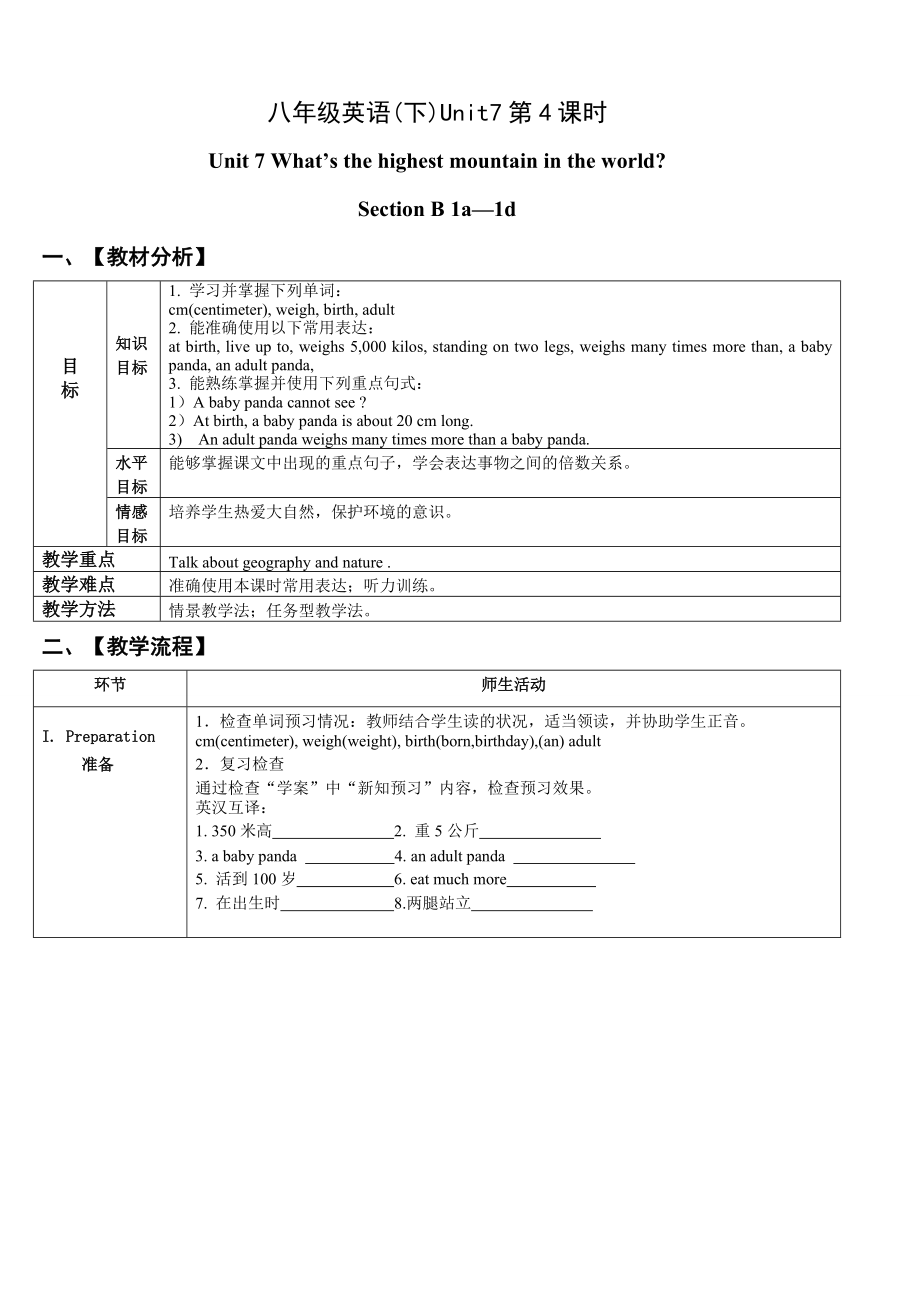《新目標(biāo)八年級(jí)英語(yǔ)下冊(cè)Unit 7第4課時(shí)》由會(huì)員分享���,可在線閱讀�,更多相關(guān)《新目標(biāo)八年級(jí)英語(yǔ)下冊(cè)Unit 7第4課時(shí)(3頁(yè)珍藏版)》請(qǐng)?jiān)谘b配圖網(wǎng)上搜索�。
1、
八年級(jí)英語(yǔ)(下)Unit7第4課時(shí)
Unit 7 What’s the highest mountain in the world?
Section B 1a—1d
一�����、【教材分析】
目
標(biāo)
[來(lái)源:21世紀(jì)教育網(wǎng)]
知識(shí)
目標(biāo)21世紀(jì)教育網(wǎng)
1. 學(xué)習(xí)并掌握下列單詞:
cm(centimeter), weigh, birth, adult
2. 能準(zhǔn)確使用以下常用表達(dá):
at birth, live up to, weighs 5,000 kilos, standing on two legs, weighs many times more tha
2�、n, a baby panda, an adult panda, [來(lái)源:21世紀(jì)教育網(wǎng)]
3. 能熟練掌握并使用下列重點(diǎn)句式:
1)A baby panda cannot see ?
2)At birth, a baby panda is about 20 cm long.
3) An adult panda weighs many times more than a baby panda.21世紀(jì)教育網(wǎng)
水平
目標(biāo)
能夠掌握課文中出現(xiàn)的重點(diǎn)句子,學(xué)會(huì)表達(dá)事物之間的倍數(shù)關(guān)系��。
情感
目標(biāo)
培養(yǎng)學(xué)生熱愛(ài)大自然�����,保護(hù)環(huán)境的意識(shí)���。
教學(xué)重點(diǎn)
Talk about
3��、geography and nature .
教學(xué)難點(diǎn)
準(zhǔn)確使用本課時(shí)常用表達(dá)��;聽(tīng)力訓(xùn)練��。
教學(xué)方法
情景教學(xué)法�;任務(wù)型教學(xué)法���。
二�、【教學(xué)流程】
環(huán)節(jié)
師生活動(dòng)
I. Preparation
準(zhǔn)備
1.檢查單詞預(yù)習(xí)情況:教師結(jié)合學(xué)生讀的狀況��,適當(dāng)領(lǐng)讀�,并協(xié)助學(xué)生正音。
cm(centimeter), weigh(weight), birth(born,birthday),(an) adult
2.復(fù)習(xí)檢查
通過(guò)檢查“學(xué)案”中“新知預(yù)習(xí)”內(nèi)容��,檢查預(yù)習(xí)效果�����。
英漢互譯:
1. 350米高 2. 重5公斤
4��、
3. a baby panda 4. an adult panda
5. 活到100歲 6. eat much more
7. 在出生時(shí) 8.兩腿站立
II. Presentation
表現(xiàn)
1. Learning tasks “示標(biāo)定向”
學(xué)習(xí)并掌握下列單詞:
cm(centimeter), weigh, birth, adult
能準(zhǔn)確使用以下常用表達(dá):
at birth, live up to, weig
5�����、hs 5,000 kilos, standing on two legs, weighs many times more than, a baby panda, an adult panda,
能熟練掌握并使用下列重點(diǎn)句式:
1)A baby panda cannot see ?
2)At birth, a baby panda is about 20 cm long.
3) An adult panda weighs many times more than a baby panda.
2. Leading-in“導(dǎo)入新課”1a
1. 應(yīng)用所給信息,比較圖中兩種動(dòng)物��。
6�、
如:This elephant weighs many times more than this panda.
(200 cm taller/shorter, weigh much more/less, eat much more/less, eat many times more)
2. 小組討論: Compare the panda and the elephant.
3. Make more sentences using the information in 1a.
如:The elephant is 350 cm tall ,and the panda is 150
7、 cm tall.
The elephant eats 150 kilos of food a day, and the panda eats 10 kilos of food a day.
III. Practice
操練
1. 1b Listen and check(√) the numbers you hear.
領(lǐng)讀數(shù)字讀法:120 one hundred and twenty ,
0.1 zero point one
核對(duì)答案:100, 20, 0.1, 0.2, 150
2. 1c Listen again and complete the
8�、sentences.
核對(duì)答案:1. 0.1 to 0.2 kilos
2. 15 cm long
3. pink , no teeth
4. 20 to 30 years
3. 應(yīng)用聽(tīng)力材料,小組準(zhǔn)備��,然后班內(nèi)討論熊貓,最后由各組成員展示:
A: A baby panda can not see.
B: An adult panda weighs many times more than a baby panda.
4. Language points:
1) At birth, a baby panda is about…
birth v. 出生 at bi
9��、rth 出生時(shí)
如: Man’s nature at birth is good. 人之初�,性本善。
give birth to… 生(孩子)�����;產(chǎn)生
如: My aunt gave birth to a beautiful baby girl yesterday.
昨天我嬸嬸生下一個(gè)漂亮的小女孩�����。
2) A panda can live up to 20 to 30 years.
up to 到達(dá)(數(shù)量���,程度等)�;不多于,如:
In some area of Africa, children get educated up to 12 years old.
在非
10�����、洲的一些地區(qū),孩子最多受教育到12歲�。
3)An adult panda weighs many times more than a baby panda. 一只成年熊貓比一只熊貓寶寶重很多倍。
weigh 意為重���、有…重��、給…稱重,其名詞形式為weight,有短語(yǔ)in weight�。
The box weighs 33 kg.=The box is 33 kg in weight.這個(gè)箱子33千克重。
many times more than 用以表示倍數(shù)��,類似短語(yǔ)還有:
many/some/twice more than ,many/some/twice less than
11��、如:I have twice more books than my sister我的書(shū)比我姐姐的多兩倍��。
IV. Consolidation
鞏固
應(yīng)用所給信息造句��,討論下列動(dòng)物的生活習(xí)性:
Here are some facts about tiger and rabbit, use the following information to make sentences.
Tiger:
— is 150 cm tall — weighs 300 kilos
— eats meat — sleeps 15 hours a day.
Rabbit:
— is 15 c
12�����、m tall — weighs 2 kilos
— eats leaves — sleeps 5 hours a day.
如:I think the tiger is heavier than the rabbit .The tiger weighs 300 kilos ,but the rabbit weighs only 2 kilos.
V. Examination
檢測(cè)
1. 引導(dǎo)學(xué)生小結(jié)梳理知識(shí)框架���、規(guī)律�����、方法��,并對(duì)合作小組當(dāng)堂學(xué)習(xí)情況進(jìn)行總結(jié)評(píng)價(jià)�����,鞏固學(xué)生所獲得的語(yǔ)言知識(shí)和經(jīng)驗(yàn)��,讓學(xué)生在評(píng)價(jià)中反思��,在反思中進(jìn)步���。
Ask one of the stud
13��、ents to say what they have learnt.
1)words & phrases
cm(centimeter), weigh, birth, adult
at birth, live up to, weighs 5,000 kilos, standing on two legs, weighs many times more than, a baby panda, an adult panda,
2) 數(shù)量單位表達(dá)法��,倍數(shù)表達(dá)法�。
2. 當(dāng)堂檢測(cè)(見(jiàn)學(xué)案):教師要隨堂進(jìn)行評(píng)價(jià)�����,批改可以由學(xué)習(xí)小組內(nèi)互批、組間互批�����、集體訂正等方法���,批閱后教師要統(tǒng)計(jì)達(dá)標(biāo)情況
14�、,收集反饋信息�����,當(dāng)堂矯正補(bǔ)救���。
VI. Assignment
作業(yè)
1. 口頭作業(yè):利用早讀,朗讀或背誦錄音材料��,體會(huì)過(guò)去進(jìn)行時(shí)的含義和用法��。
2. 書(shū)面作業(yè):
1)記憶所學(xué)單詞��、短語(yǔ)或重點(diǎn)句型�。
2)Finish off the exercises in tongbuxuexi.
3. Preview the new words of 2a-2e.
三、【板書(shū)設(shè)計(jì)】
Unit 7 What’s the highest mountain in the world?
Section B 1a—1d
1)A baby panda cannot see ?
2)At birth, a baby panda is about 20 cm long.
3) An adult panda weighs many times more than a baby panda.
四�、【教后反思】
能夠掌握課文中出現(xiàn)的重點(diǎn)句子�����,學(xué)會(huì)表達(dá)事物之間的倍數(shù)關(guān)系�。
 新目標(biāo)八年級(jí)英語(yǔ)下冊(cè)Unit 7第4課時(shí)
新目標(biāo)八年級(jí)英語(yǔ)下冊(cè)Unit 7第4課時(shí)

